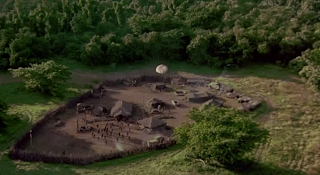Michael Douglas (taking the role of Nicholas Van Orton a successful banker who keeps to himself ) and Sean Penn (playing Conrad) star as brothers in the 1997 mystery and psychological thriller, 'The Game'. When Conrad returns on his birthday with an strange gift-participation in a personalised real-life game. Nicolas reluctantly accepts. Starting of harmless, the game grows increasingly personal, and Nicholas begins to fear for his life as he avoids agents from mysterious game's organisers. Orton must find answers for himself, after being left with no one to trust and no money.
1997, 'The Game' has a production logo of polygram films entertainment connoting the time the movie was produced and filmed and also the location, this is denoted as the company founded in 1980 and an European competitor to hollywood, after it was sold in 1998. Therefore the movie an be signified as one of the last before the company was sold off to the, 'Seagram company'. The typography is in a basic white font, connoting the straight forward font and content of the text symbolise the straight forwardness of the narrative. The white text is an high contrast against the black plain background, signifying a light in the darkness. This can also be signified to conform Todorov's theory, connoting the dark as disequilibrium and the white font as equilibrium. Fitting in with the conventions of a thriller genre as the darkness (disequilibrium) is a larger volume than the light (equilibrium).
The montage of shots edited in a subliminal manner, connote as a flash back due to denotations of a old television filter on them. The flashbacks are signified in a negative light, as if it's events that have scarred the protagonist, as they are shot in low key lighting connoting that they are a dark memory, being relived in a failed attempt to forget them. These shots are also filmed in de-saturated lighting to signify the age of the shots. A large portion of the film opening sequence is taken up by the flash backs, this signifies the strong tragic hold they have over the protagonist, leaving the demographic with enigma. However the remaining portion of the title sequence is a shot of a male protagonist washing his face, this connotes his attempt to wash away the thoughts or even signifies the hot clammy state the memories/ flash backs get him into. As these shots are also filmed in low key lighting it connotes that even though the bad is over the past still lingers and haunts him in the present. It also may signify a foreshadow chain of events that will lead the disruption stage.
The narrative is very restricted, leaving the target audience with enigma. Also due to the use of a flashbacks being present the movie as anachronic narrative. Non-diegetic and diegetic soundtracks are used in the production, a non-diegetic soundtrack playing before the images are shown makes the audience worried and weary of what is to come. The non-diegetic soundtrack connotes as an cover-up to scare and distract the demographic from the truth seeking through in subliminal messages. The non-diegetic soundtrack of an olden pianist conforms to the ideology of the flashback, it's parallel and synchronous connoting that it's from an older past like a flash back would be. The diegetic sound of the water after the protagonist washed his face, signifies as breaking the soft music of the flashback brings himself and the demographic back into the present and reality.













